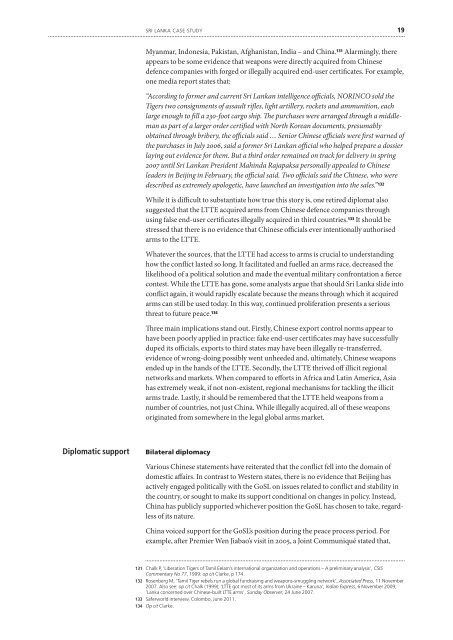FAB Sri Lanka
FAB Sri Lanka
FAB Sri Lanka
Create successful ePaper yourself
Turn your PDF publications into a flip-book with our unique Google optimized e-Paper software.
Diplomatic support<br />
s r i l a n k a c a s e s t u d y 19<br />
Myanmar, Indonesia, Pakistan, Afghanistan, India – and China. 131 Alarmingly, there<br />
appears to be some evidence that weapons were directly acquired from Chinese<br />
defence companies with forged or illegally acquired end-user certificates. For example,<br />
one media report states that:<br />
“According to former and current <strong>Sri</strong> <strong>Lanka</strong>n intelligence officials, NORINCO sold the<br />
Tigers two consignments of assault rifles, light artillery, rockets and ammunition, each<br />
large enough to fill a 230-foot cargo ship. The purchases were arranged through a middleman<br />
as part of a larger order certified with North Korean documents, presumably<br />
obtained through bribery, the officials said … Senior Chinese officials were first warned of<br />
the purchases in July 2006, said a former <strong>Sri</strong> <strong>Lanka</strong>n official who helped prepare a dossier<br />
laying out evidence for them. But a third order remained on track for delivery in spring<br />
2007 until <strong>Sri</strong> <strong>Lanka</strong>n President Mahinda Rajapaksa personally appealed to Chinese<br />
leaders in Beijing in February, the official said. Two officials said the Chinese, who were<br />
described as extremely apologetic, have launched an investigation into the sales.” 132<br />
While it is difficult to substantiate how true this story is, one retired diplomat also<br />
suggested that the LTTE acquired arms from Chinese defence companies through<br />
using false end-user certificates illegally acquired in third countries. 133 It should be<br />
stressed that there is no evidence that Chinese officials ever intentionally authorised<br />
arms to the LTTE.<br />
Whatever the sources, that the LTTE had access to arms is crucial to understanding<br />
how the conflict lasted so long. It facilitated and fuelled an arms race, decreased the<br />
likelihood of a political solution and made the eventual military confrontation a fierce<br />
contest. While the LTTE has gone, some analysts argue that should <strong>Sri</strong> <strong>Lanka</strong> slide into<br />
conflict again, it would rapidly escalate because the means through which it acquired<br />
arms can still be used today. In this way, continued proliferation presents a serious<br />
threat to future peace. 134<br />
Three main implications stand out. Firstly, Chinese export control norms appear to<br />
have been poorly applied in practice: fake end-user certificates may have successfully<br />
duped its officials, exports to third states may have been illegally re-transferred,<br />
evidence of wrong-doing possibly went unheeded and, ultimately, Chinese weapons<br />
ended up in the hands of the LTTE. Secondly, the LTTE thrived off illicit regional<br />
networks and markets. When compared to efforts in Africa and Latin America, Asia<br />
has extremely weak, if not non-existent, regional mechanisms for tackling the illicit<br />
arms trade. Lastly, it should be remembered that the LTTE held weapons from a<br />
number of countries, not just China. While illegally acquired, all of these weapons<br />
originated from somewhere in the legal global arms market.<br />
Bilateral diplomacy<br />
Various Chinese statements have reiterated that the conflict fell into the domain of<br />
domestic affairs. In contrast to Western states, there is no evidence that Beijing has<br />
actively engaged politically with the GoSL on issues related to conflict and stability in<br />
the country, or sought to make its support conditional on changes in policy. Instead,<br />
China has publicly supported whichever position the GoSL has chosen to take, regardless<br />
of its nature.<br />
China voiced support for the GoSL’s position during the peace process period. For<br />
example, after Premier Wen Jiabao’s visit in 2005, a Joint Communiqué stated that,<br />
131 Chalk P, ‘Liberation Tigers of Tamil Eelam’s international organization and operations – A preliminary analysis’, CSIS<br />
Commentary No 77, 1999: op cit Clarke, p 174.<br />
132 Rosenberg M, ‘Tamil Tiger rebels run a global fundraising and weapons-smuggling network’, Associated Press, 11 November<br />
2007. Also see: op cit Chalk (1999); ‘LTTE got most of its arms from Ukraine – Karuna’, Indian Express, 6 November 2009;<br />
‘<strong>Lanka</strong> concerned over Chinese-built LTTE arms’, Sunday Observer, 24 June 2007.<br />
133 Saferworld interview, Colombo, June 2011.<br />
134 Op cit Clarke.


